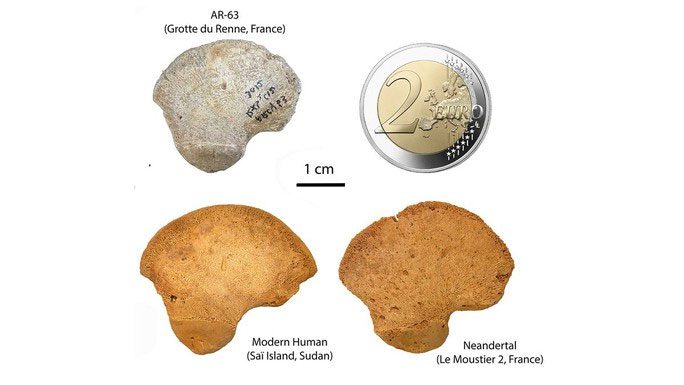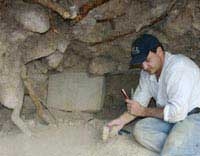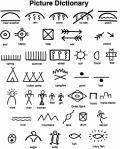A fragment of a skeleton found in a cave 200 kilometers from Paris has puzzled scientists because it does not fully resemble modern humans, nor is it entirely like the Neanderthal species.
According to Live Science, the fragment is the hip bone of an infant, discovered in the Grotte du Renne cave in Arcy-sur-Cure, located about 200 km southeast of the French capital.
The cave is situated in an area known as Châtelperronian, which extends from northwest Spain to the Paris Basin, where Neanderthals lived approximately 44,500 to 41,000 years ago.

The strange hip bone, coded AR-63, was compared with similar bones from two species: Homo sapiens and Neanderthals – (Photo: SCIENTIFIC REPORTS)
Neanderthals are a close sister species to modern humans (Homo sapiens), both belonging to the genus Homo and having become extinct around 30,000 to 40,000 years ago.
The Grotte du Renne cave is also famous for many Neanderthal remains that have been found. The aforementioned strange hip bone, while sharing some characteristics, is not Neanderthal, even though it is surrounded by a plethora of Neanderthal remains.
The hip bone resembles that of modern humans more than Neanderthals, although it is not entirely modern.

An analysis shows that the child’s bone AR-63 is “floating” between the worlds of modern humans and an extinct species – Photo: SCIENTIFIC REPORTS
The research team, led by anthropologist Bruno Maureille from the University of Bordeaux and the French National Centre for Scientific Research (CNRS), concluded: “We have found a lineage of anatomically modern humans.”
The study published in the journal Scientific Reports suggests that the most likely scenario is that the aforementioned child belonged to an early lineage of Homo sapiens, with some traits that are not entirely “modern.”
Additionally, the child’s presence among the Neanderthal community may indicate that our ancestors coexisted with Neanderthals at this site, possibly sharing a culture.
It is likely that some of the “non-modern” traits in this infant are due to it being a “hybrid” between the two species, with Homo sapiens predominating.
Interbreeding between different human species has been common in the past. Some people in Northern Europe may carry up to 2% of Neanderthal DNA and possess skulls resembling Neanderthals, while many Asians still retain certain characteristics of the Denisovans.
This discovery also promises to lead to more significant insights. For instance, it raises questions about how Homo sapiens survived in an area that seemed to be the territory of Neanderthals; how the two species coexisted, shared culture, and technology, as well as the mysterious reasons behind the Neanderthals’ extinction.
The remains of the child in the Châtelperronian are at the center of much debate. A prominent archaeologist at the University of Toulouse (France), Dr. Ludovic Silmak, argues that it is, in fact, Homo sapiens and serves as evidence of how our ancestors penetrated the world of Neanderthals.





















































